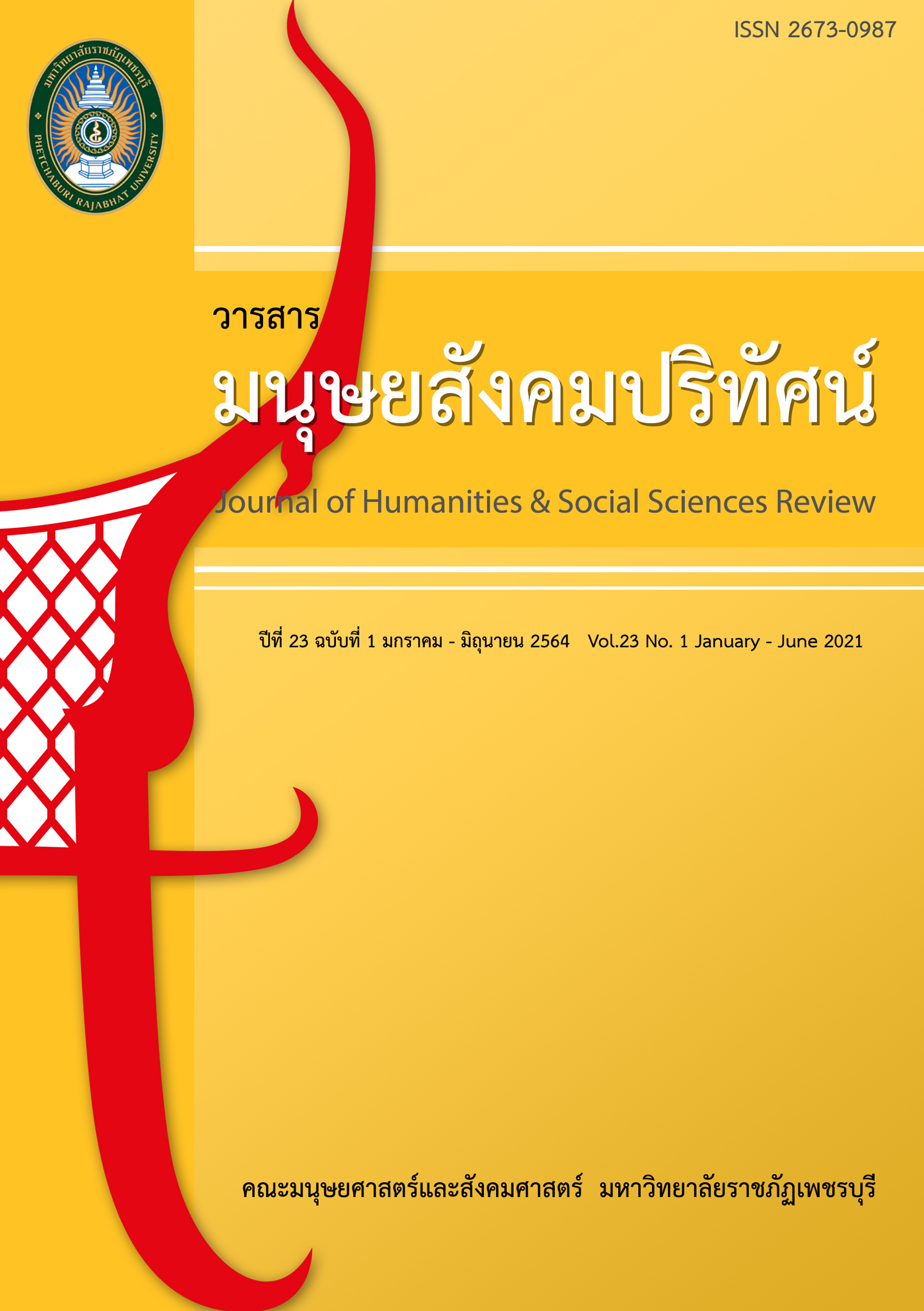อารมณ์ขันในรายการเทยเที่ยวไทย
Main Article Content
บทคัดย่อ
บทความฉบับนี้เป็นส่วนหนึ่งของการศึกษาค้นคว้าอิสระ หลักสูตรภาษาไทยเพื่อการพัฒนาอาชีพ ภาควิชาภาษาไทย บัณฑิตวิทยาลัย มหาวิทยาลัยศิลปากร มีวัตถุประสงค์เพื่อศึกษากลวิธีทางภาษาเพื่อสร้างอารมณ์ขัน ในรายการ “เทยเที่ยวไทย” โดยคัดเลือกเฉพาะตอนที่ออกอากาศทางสถานีโทรทัศน์ช่องวัน (ONE HD 31) ตั้งแต่เดือนกันยายน ถึงเดือนพฤศจิกายนพ.ศ. 2561 เท่านั้น มีทั้งหมดจำนวน 13 ตอน ผลการศึกษาวิเคราะห์พบว่า กลวิธีการใช้คำเพื่อสร้างอารมณ์ขันพบทั้งหมด 44 ครั้ง สามารถแบ่งได้ดังนี้ 1) การปนภาษา พบ 3 ครั้ง 2) การใช้คำพ้อง พบ 17 ครั้ง 3) การใช้คำผวน พบ 10 ครั้ง 4) การใช้คำภาษาถิ่น พบ 13 ครั้ง และ 5) การใช้คำสองแง่สองง่าม พบ 1 ครั้ง อย่างไรก็ตาม การใช้คำพ้องถือเป็นกลวิธีที่พบมากที่สุด ซึ่งสอดคล้องกับทฤษฎีความผ่อนคลายมากที่สุด จะเห็นได้ว่าผู้ดำเนินรายการได้ใช้วิธีการสื่อสารทางภาษาเพื่อสร้างอารมณ์ขันผ่านการสอดแทรกมุกตลก
Article Details
1. มุมมองและความคิดเห็นใด ๆ ในบทความเป็นมุมมองของผู้เขียน คณะบรรณาธิการไม่จำเป็นต้องเห็นด้วยกับมุมมองเหล่านั้นและไม่ถือเป็นความรับผิดชอบของคณะบรรณาธิการ ในกรณีที่มีการฟ้องร้องเกี่ยวกับการละเมิดลิขสิทธิ์ ให้ถือเป็นความรับผิดชอบของผู้เขียน แต่เพียงผู้เดียว
2. ลิขสิทธิ์บทความที่เป็นของคณะมนุษยศาสตร์และสังคมศาสตร์ มหาวิทยาลัยราชภัฏเพชรบุรีมีลิขสิทธิ์ถูกต้องตามกฎหมาย การเผยแพร่จะต้องได้รับอนุญาตโดยตรงจากผู้เขียนและมหาวิทยาลัยราชภัฏเพชรบุรีเป็นลายลักษณ์อักษร
เอกสารอ้างอิง
2. กฤษมันต์ วัฒนาณรงค์. (2537). อารมณ์ขันในการสอน. พัฒนาเทคนิคศึกษา, 6(12): 3-7.
3. กาญจนา เจริญเกียรติบวร. (2548). การวิเคราะห์วาทกรรม เรื่อง ตลกภาษาไทย. วิทยานิพนธ์อักษรศาสตร ดุษฎีบัณฑิต จุฬาลงกรณ์มหาวิทยาลัย.
4. นภัสสรณ์ นาคแก้ว. (2556). การปนภาษาอังกฤษในภาษาไทย: กรณีศึกษารายการเทยเที่ยวไทย. ปริญญานิพนธ์ศิลปศาสตรมหาบัณฑิต มหาวิทยาลัยศิลปากร.
5. ปวริศ มินา. (2561). กลวิธีการสร้างสรรค์ความตลกในรายการโทรทัศน์ไทย. วารสารฉบับภาษาไทย สาขา มนุษยศาสตร์ สังคมศาสตร์ และศิลปะ มหาวิทยาลัยศิลปากร, 11(3): 2301-2302.
6. รุ่งอรุณ ฉัตรวิฆเนศ. (2553). ศักยภาพของมุขตลกและอารมณ์ขันในรายการโทรทัศน์. วิทยานิพนธ์นิเทศศาสตรมหาบัณฑิต จุฬาลงกรณ์มหาวิทยาลัย.
7. วรพร อินทเชื้อ. (2526). วิเคราะห์อารมณ์ขันเชิงเสียดสีในงานประพันธ์ประเภท Fiction ของ เอเลนซิลลิโท. ปริญญานิพนธ์การศึกษามหาบัณฑิต มหาวิทยาลัยศรีนครินทรวิโรฒ.
8. วิลาศ มณีวัต. (2516). สายลมแสงแดด. กรุงเทพฯ: ก้าวหน้า.
9. สุพัตรา สุภาพ (2518). สังคมและวัฒนธรรมไทย. กรุงเทพฯ: ไทยวัฒนาพาณิช.
10.แสงสุรีย์ สำอางกูล. (2531). จิตวิทยาภาษา. เชียงใหม่: คณะมนุษยศาสตร์ มหาวิทยาลัยเชียงใหม่.
11. อมรา ประเสริฐสินธุ์. (2548). ภาษาในสังคมไทย: ความหลากหลาย การเปลี่ยนแปลง และการพัฒนา (พิมพ์ครั้งที่ 4). กรุงเทพฯ: โรงพิมพ์แห่งจุฬาลงกรณ์มหาวิทยาลัย.
12. อันธิยา หล่อเรืองศิลป์. (2549). การวิเคราะห์กลวิธีการใช้ภาษาเพื่อสร้างอารมณ์ขันในละครตลกสถานการณ์เรื่องบางรักซอย 9. วิทยานิพนธ์ศึกษาศาสตรมหาบัณฑิต มหาวิทยาลัยเชียงใหม่.
13. อุบลรัตน์ ศิริยุวศักดิ์. (2536). อารมณ์ขันในสื่อมวลชน. กรุงเทพฯ: โครงการหนังสือชุดวิจัยและพัฒนานิเทศศาสตร์.


